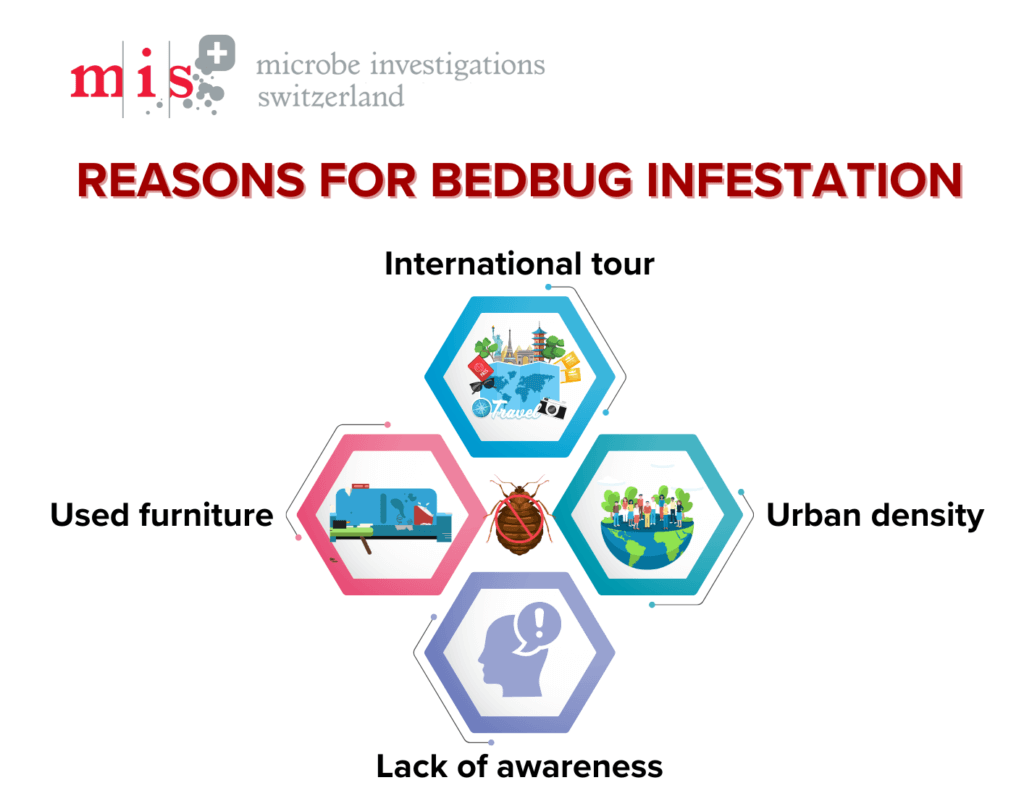Bed bug infestations have become a significant and growing concern worldwide impacting both urban and rural areas. These tiny pests have become a major public health issue capable of causing various skin reactions and contributing to psychological stress. This article discusses the most heavily bed bug-infested regions around the world, understanding the root causes and highlighting effective control measures to be taken including the important role of testing services in preventing these infestations.
Understanding Bed Bug Infestations
Before discussing the cities most affected by bed bugs let us understand what bed bugs are and why they have become such a significant issue.
Bed bugs are scientifically known as Cimex lectularius. Bed bugs are small, nocturnal insects that feed on human blood. They cannot fly since they lack wings yet they attach themselves firmly to clothing, luggage, and furniture, which significantly aids in their rapid spread across various environments.
The recurrence of bed bug infestation was caused by factors such as
- Increased globalization,
- Expanded urban development,
- Development of pesticide resistance,
- Lack of public awareness.
These factors have made managing bed bug infestations difficult for both developing and developed countries.
Top Bed Bug-Infested Cities and Regions
North America
The major reasons for cities like New York, Toronto, and Chicago to be the most affected by bed bug infestations in North America are
- high population,
- flourishing tourism, and
- extensive public transportation networks.
New York City, USA
New York is the most affected city in the USA and it has seen a significant uneasiness among the people, higher costs for treating homes and businesses, and a negative reputation in infested areas. The city’s crowded population, large numbers of tourists, use of shared housing and public transportation, and many apartment buildings provide perfect conditions for bed bugs to flourish.
Toronto, Canada
Toronto has seen a sudden increase in bed bug problems due to its increasing population and frequent changes of residents in rental properties. Despite considerable public awareness and efforts by local authorities, bed bugs remain a serious problem in the city.
Europe
In Europe, cities like London, Paris, and Berlin have been infested by bed bugs creating huge problems mainly caused due to the increase in international visitors and tourism.
London, UK
London’s historic buildings and shared housing facilitate bed bug infestation. The city’s global connectivity attracts millions of visitors annually aiding the spread of bed bugs across hotels, hostels, and residential areas.
Paris, France
Paris has old architecture, tourist sites, and densely populated residential areas to create a hotspot for bed bugs. The frequent change of residents and tourists along with active nightlife allows bed bugs to spread extensively and unnoticed.
Asia and Australia
Major urban cities like Mumbai, Tokyo, and Sydney in Asia and Australia have been infested with bed bugs. Factors contributing to the infestation include
- high population density,
- climatic conditions favorable to bed bugs, and
- international connectivity.
Sydney, Australia
Sydney is Australia’s largest city and a major international travel hub hence it faces bed bug challenges mainly in its accommodation sector which includes luxury hotels to hostels which are places perfect for bed bugs to flourish.
Mumbai, India
Mumbai’s dense population and high humidity create an ideal climate for bed bugs. The city’s large slums and congested residential areas facilitate the rapid spread of bed bugs and complicate control efforts to prevent infestation.
Tokyo, Japan
Bed bugs have infested Tokyo because of its high population density and significant domestic and international travel. Places such as capsule hotels and public sleeping areas present unique challenges for bed bug control making it difficult to prevent the spread of bed bugs.
Reasons for Bed bug infestations

- International tour: Traveling internationally is the most important cause of spreading bed bugs. Places such as airports, hotels, and public transport that connect tourists are most susceptible to the spread and act as the major contributing factor for bed bug infestation.
- Urban density: Cities with a high population have more places that are close together making it easier for bed bugs to spread from one location to another.
- Used furniture: The practice of buying and selling used furniture can highly contribute to spreading bed bugs.
- Lack of awareness: In many places, there is still very little awareness about bed bugs, and because of that infestations are not reported or treated in time.
Control Measures and the Importance of Testing
The important control measures for preventing the infestation of bed bugs are
- Public education initiatives,
- Professional extermination services,
- Preventative strategies such as the use of repellent products
Among these, the development of effective repellant products against bed bugs and ensuring the effectiveness of these products is the most important aspect to be considered. Yet not all these products are equally effective hence these products must be subjected to intensive testing to evaluate their effectiveness and to test whether they are safe for human use and are also not polluting the environment. These properties can be tested through various standard test methods specifically designed for bed bug repellants.
Bed Bug Repellent Tests
Effective repellent products significantly help to reduce the risk of bed bug bites and infestations thus minimizing health risks and psychological stress associated with these pests. Testing services play an important role in bringing these products to market ensuring they meet regulatory standards and are effective in practical conditions.
Various tests are utilized to analyze the efficacy of bed bug repellents ensuring that these products are effective in reducing or preventing bed bug activities. The testing methodologies for bed bug repellents vary depending on their specific applications but typically include the following approaches:
- Petri Dish Repellency Assay: Analyses the repellency of treated surfaces by observing the crawling behavior of bed bugs.
- No-Choice (Barrier) Test: Analyses the effectiveness of repellents in forming a barrier that prevents bed bugs from accessing a particular area or surface.
- Harborage Choice Test: Analyses the efficacy of repellent products on bed bug behavior in treated and untreated places.
- Olfactory Tests: Identifies if repellents work by smell (olfactory) or direct contact.
- Residual Efficacy Test: Analyses how long a repellent continues to be effective after it has been applied.
- Safety and Efficacy Tests Under Field Conditions: Analyses repellents in practical conditions to see how well they perform in actual use.
Bed bug infestations are a major global issue in some cities and regions. In order to prevent these infestations, it is necessary to analyze the reasons for these outbreaks and take necessary preventive measures to avoid them. Testing services for repellent products such as those provided by MIS are essential for confirming the effectiveness and safety of these products which will improve public health and help in preventing such infestations.
At MIS, we offer a wide range of entomology testing services for the manufacturers of insecticides and pesticides used in domestic, agricultural, vector disease management, and industrial applications.
Our team of entomologists performs tests based on standard methodologies that are internationally recognized for evaluating the effectiveness of repellant products.
To get a quotation and to know more about our bed bug product repellency testing services, please consult with our experts.









